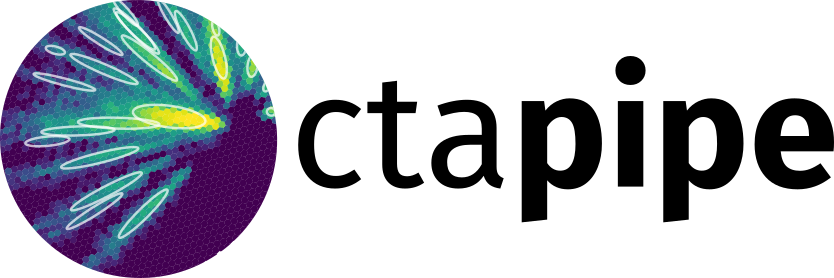"""
Table interpolation class, to allow interpolation of 2D images in any number of other
dimensions. Reads in an interim FITS table as defined below:
Tables organised as a standard FITS image file with each table as an image HDU.
---------------
First (primary) HDU must contain the following header entries:
CRPIXx, CRVALx, CRDELTAx: Number, position and pixel spacing of the reference pixel in
the image. Where x is the axis number (1 or 2).
GRIDVALS: Names of values describing the grid points
e.g. GRIDVALS = ALT,AZ
---------------
Each HDU must contain a header entry containing the grid points described by GRIDVALS
e.g. ALT =70
AZI = 0
It is also strongly recommended to include documentation for each interpolation
dimension containing at least the units. This entry ust begin with DOC, followed by the
dimension name
e.g. DOCALT = "Altitude of event (deg)"
TODO:
- Improve error handling
- Add option for caching nd interpolated value
- Better deal with edges of phase space
- Allow non-linear interpolation
"""
import numpy as np
from astropy.io import fits
from scipy import interpolate
[docs]
class TableInterpolator:
"""
This is a simple class for loading lookup tables from a fits file and
interpolating between them
"""
def __init__(self, filename, verbose=1):
"""
Initialisation of class to load templates from a file and create the interpolation
objects
Parameters
----------
filename: string
Location of Template file
verbose: int
Verbosity level,
0 = no logging
1 = File + interpolation point information
2 = Detailed description of interpolation points
"""
self.verbose = verbose
if self.verbose:
print("Loading lookup tables from", filename)
grid, bins, template = self.parse_fits_table(filename)
x_bins, y_bins = bins
self.interpolator = interpolate.LinearNDInterpolator(
grid, template, fill_value=0
)
self.nearest_interpolator = interpolate.NearestNDInterpolator(grid, template)
self.grid_interp = interpolate.RegularGridInterpolator(
(x_bins, y_bins),
np.zeros([x_bins.shape[0], y_bins.shape[0]]),
method="linear",
bounds_error=False,
fill_value=0,
)
[docs]
def parse_fits_table(self, filename):
"""
Function opens tables contained within fits files and parses them into a format
recognisable by the interpolator.
Parameters
----------
filename: str
Name of table file
Returns
-------
tuple (grid points, bin centres, images)
"""
file = fits.open(filename)
template = list()
grid = list()
primary_hdu = file[0].header # We require first HDU to be primary
# Below definitions are standard
ix, iy = primary_hdu["CRPIX2"], primary_hdu["CRPIX1"]
val_x, val_y = primary_hdu["CRVAL2"], primary_hdu["CRVAL1"]
print(val_x, val_y)
delta_x, delta_y = primary_hdu["CRDELTA2"], primary_hdu["CRDELTA1"]
nbins_x, nbins_y = primary_hdu["NAXIS2"], primary_hdu["NAXIS1"]
ix *= delta_x
iy *= delta_y
x_bins = np.arange(val_x - ix, val_x + (delta_x * nbins_x) - ix, step=delta_x)
y_bins = np.arange(val_y - iy, val_y + (delta_y * nbins_y) - iy, step=delta_y)
grid_vals = primary_hdu["GRIDVALS"]
points = grid_vals.split(",")
if self.verbose:
print("Interpolation point source be called in order", points)
if self.verbose > 1:
for p in points:
print(p, ":", primary_hdu["DOC" + p])
for hdu in file:
template.append(hdu.data)
hdu_pt = list()
for p in points:
hdu_pt.append(hdu.header[p])
grid.append(np.array(hdu_pt))
print(np.array(grid))
bins = (x_bins, y_bins)
return grid, bins, template
[docs]
def interpolate(self, params, pixel_pos_x, pixel_pos_y):
"""
Parameters
----------
params: ndarray
numpy array of interpolation parameters
currently [energy, impact distance, xmax]
pixel_pos_x: ndarray
pixel position in degrees
pixel_pos_y: ndarray
pixel position in degrees
Returns
-------
ndarray of expected intensity for all pixel positions given
"""
image = self.interpolated_image(params)
self.grid_interp.values = image
points = np.array([pixel_pos_x, pixel_pos_y])
return self.grid_interp(points.T)
[docs]
def interpolated_image(self, params):
"""
Function for creating a ful interpolated image template from the interpolation library
Parameters
----------
params: ndarray
numpy array of interpolation parameters
currently [energy, impact distance, xmax]
Returns
-------
ndarray of a single image template
"""
image = self.interpolator(params)[0]
if np.isnan(image).all():
print("Found a NaN", params)
image = self.nearest_interpolator(params)[0]
return image

